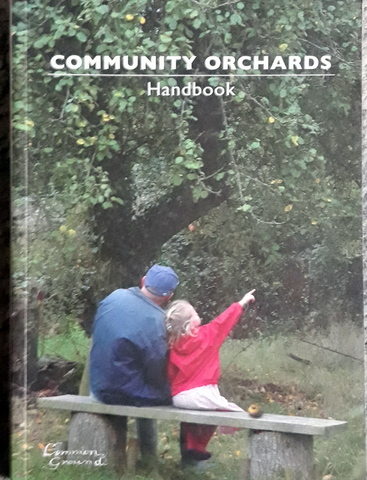I originally wrote an entry for the library about fruits, nuts and berries back in 2011. When I originally published it, I did not include any photos of the book covers as I usually do, but I have recently corrected that oversight. This original article is available here.
Since 2011 I have collected a number of fruit growing books, but not so much nuts and berries. Here are those books!
Growing Fruit in Australia (4th Ed.) – Paul Baxter & Glenn Tankard – The Macmillan Co of Aust. Pty. Ltd (AUS) 1990 ISBN 978 0 7329 0305 X – This is a comprehensive book, divided into four sections. Section one covers planning an planting an orchard, including subjects like choosing fruit to suit your climate, soil fertility, water needs of fruit trees and buying, planting and training the young tree. Section two covers a year in the life of a fruit tree including flowering, pollination and fruit set, propagation, pruning and pests and diseases, with organic and non-organic control strategies covered. Section Three covers fruit/nut tree families talking about requirements for climate. Soil and fetilisers, rootstocks, harvesting, yields, pests and diseases for pome, stone fruits, nuts, mulberries and figs, citrus, vines, subtropical and warm climate fruit and berry fruits. Section four is a sort section on making money from fruit. The book has lots of line drawings and black and white photos as well as some colour photo sections.
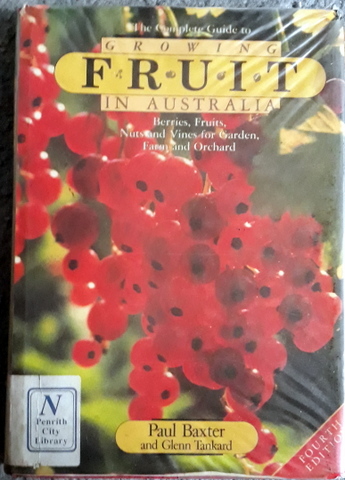
The Complete Book of Fruit Growing in Australia – Louis Glowinski – Hachette Australia (AUS) 2011 (reprinted) ISBN 978 0 7336 2407 0 – This is another comprehensive (and weighty) tome! The book is broken up into 23 chapters, with each chapter covering a different nuts, fruit or berry group. This translates into over 130 separate fruit/berry/nut monographs covering varieties and history, cultivation and training, harvesting, pests and diseases and propagation. As well as the more common fruits and berries, the book covers elderberries and related fruits subtropicals like sapote and jujube, native fruits, palms, papayas and cactus fruits, guavas, monster and rose hips. There are a few line drawings and colour photos, but most of the illustrations are black and white photos.
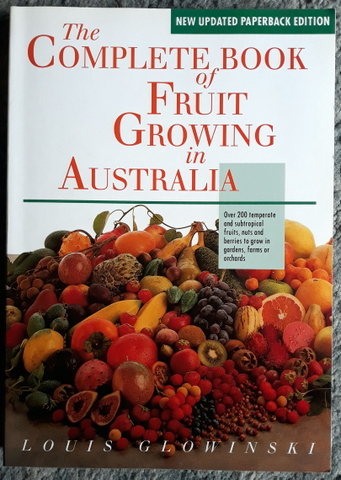
Better Fruit Growing (for Australian Gardeners) – Duncan Brown – Landsowne Press (AUS) 1963 ISBN 978 0 7018 0131 1 – The book is broken up into 56 sections of four to five pages in length. The first twenty five sections cover setting and maintaining a small orchard, covering such subjects as frost, purchasing and planting trees, fruit thinning, cordon and espalier, pruning and shaping, pollination, budding and grafting, pests and diseases, soil management, watering and hormone use. Spray charts are old school and definitely not organic! The following sections are monographs on fruits berries and nuts, and each monograph covers history, varieties, harvesting, manuring, diseases and pruning. The book has two sections of black and white photos and no other illustrations.
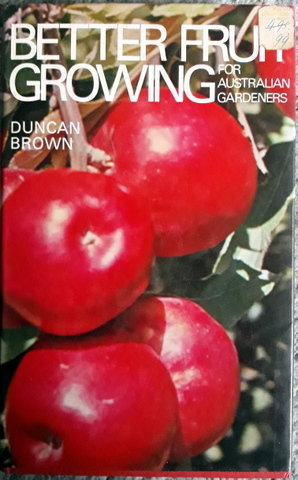
Organic Fruit Growing – Annette McFarlane – ABC Books (AUS) 2011 ISBN 978 0 7333 2913 5 – The book is broken up into two parts – Part one is techniques and methods for growing organic fruit trees. It gives an introduction to organics, how to get started, preparing to plant, pruning and training, tree nutrition, pest and disease prevention and control, pollination, propagation and weeds. Part two is an A to Z of fruit, providing monographs on 58 fruits and berries. Each monograph provides an introduction to the species, a description (including colour photo), location and climate where they grow, cultivation, pruning and training, pot culture, varieties, potential problems (pests, diseases etc.), Harvesting and storage, and propagation. There is a section at the end detailing 23 recipes with various fruits. The book has lots of colour photos.
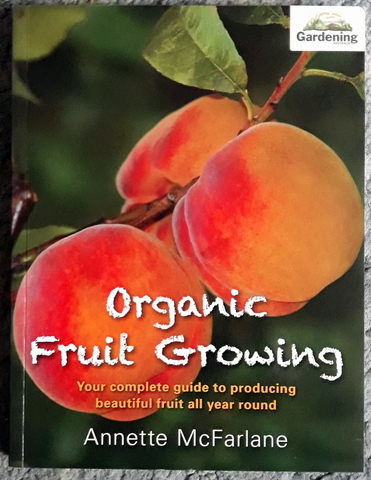
Home Fruit Growing – Dept. of Agriculture NSW (AUS) 1984 ISBN 978 0 7240 8689 7 – Chapter one of the book covers planning and preparation including soils and soil preparation, drainage, nutrition, growing, pruning and propagation, harvesting and storing fruit. The next eight chapters provide monographs on various fruit broken down by type such as – Citrus, stone fruits, pome fruits, grapes, berries, tropical fruit, nuts, and miscellaneous fruit such as figs, olives, kiwifruit and feijoas. Each monograph covers varieties, propagation where they can be grown, planting and caring, nutrition, pruning, harvesting and pests and diseases. Chapter ten talks what varieties of each fruit can be grow where (in NSW). Chapter eleven goes into more detail around pest and disease control for the more common fruit but is not organic. There is a supplement provided with the book detailing pest and disease chemical control sprays which is also not organic! The book has quite a lot of line drawings.
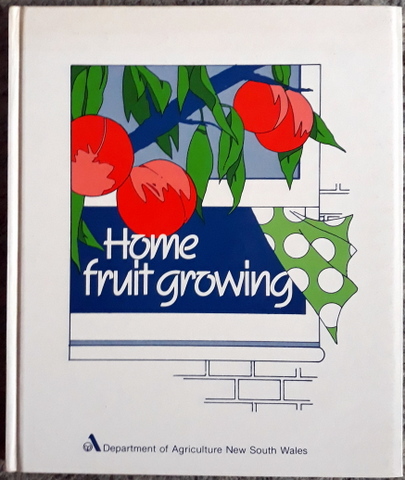
The Complete Guide to Fruit Growing – Peter Blackburne-Maze – The Crowood Press (UK) 2010 ISBN 978 1 84797 173 9 – This also a small book, not as comprehensive or detailed as books mentioned above, and it reflects the UK experience. Chapter one talks about the history of fruit growing (in UK) and chapter two covers different ways of growing fruit meaning the various ways fruit trees can be pruned. Chapter three covers the kinds and varieties of fruit, talking about soils, varieties, effects of the site, rootstocks and propagation. Chapter four covers planning, planting and aftercare including soil preparation, marking out, planting, soil management and watering. Chapter five covers pest diseas and weed control, not organic and not much detail. Chapter six covers pruning and growth control, chapter seven covers fruit picking and storage, Chapter eight is interesting covering the growing of various fruits in a greenhouse including citrus and pineapples. The rest of the book is a ‘Fruit Reference Section’ giving some detail on growing various fruit including varieties, some pests and diseases and some pruning. The book has a centre section of colour photos with the rest of the book being taken up with line drawings.
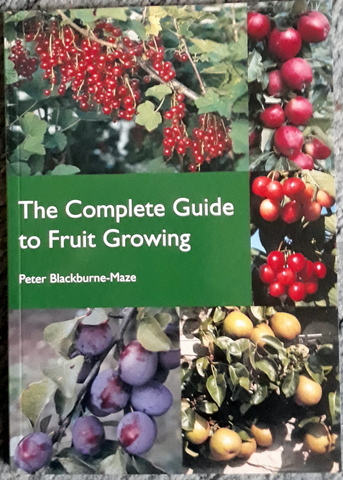
The Easy Fruit Garden – Clare Matthews – Hobble Creek Press (US) 2012 ISBN 978 1 4621 1291 3 – This book is broken up into three parts, part one is planning and design including how and what to grow, putting design together, soil prep and where to grow fruit. Part two covers what to grow including monographs on tree fruit (13), soft fruit (14), nuts (4), ‘other fruits’ (5) including rhubarb, melon and passionfruit, and ‘almost wild’ (3) sloes, rowan and elder. Part three addresses how to grow, including sections on planting, pruning, mulch, compost, watering, weeding, natural defences, companion planting (the US experience), pests and diseases including organic controls, the fruit garden timetable, storing fruit and tools required. The book has lots of colour photos.
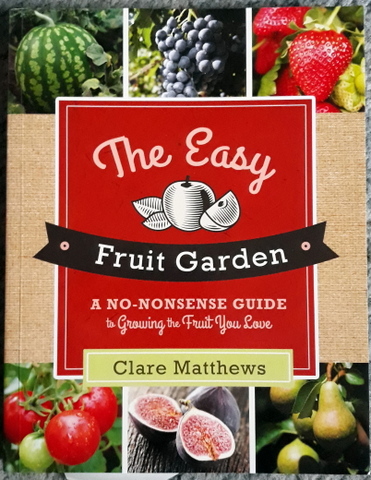
Citrus – Allen Gilbert – Hyland House Publishing (AUS) 2007 ISBN 978 1 86447 103 8 – This comprehensive book is broken up into seven chapters. Chapter one covers the origin and spread of citrus trees, chapter two discusses species and cultivars including, sweet citrus, sour citrus, large citrus, citrus grown for their leaves and Australian native citrus. Chapter three covers propagation including seed, cuttings, budding and grafting. Chapter four covers citrus tree management in the open orchard and in pots and there is a small section on the organic citrus grove. Chapter five covers pruning and training of citrus trees including training young trees, espalier, pruning established trees and equipment required. Chapter six covers pest and disease control of citrus with an organic approach. Chapter seven provides a couple of pages on harvesting and storage of citrus fruit. The book has lots of colour photos.
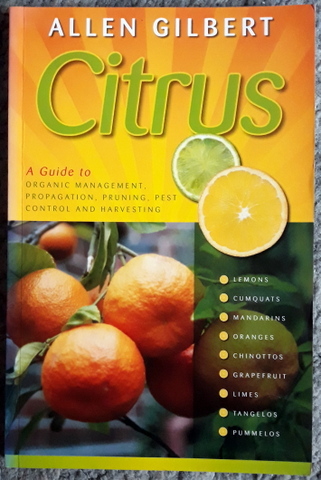
All About Apples – Allen Gilbert – Hyland House Publishing (AUS) 2001 ISBN 978 1 86447 046 1 – This book covers all you would want to know for apple growing in Australia. It starts off in chapter one with some apple history, myths and customs, moving on I nchapter two to comprehensive lists of early and heritage apples, cultivars available here in the 1930s, heritage cultivars available today and modern Australian cultivars with a description of the fruit and some photos. Chapter three covers caring for apple trees and chapter four covers pruning, including a new approach to summer pruning apple trees. Chapter five covers pests and diseases of apples, referring to organic treatments where they exist. Treatments may have moved on since the book was written over 20 years ago. Chapter six covers growing your own apple trees, including your own rootstock from seed, budding and grafting and planting young apple trees. Chapter seven covers apple flowering and maturity and apple storage. Chapter covers setting up your own orchard with reference to permaculture principles. The book has lots of colour photos and some line drawings.
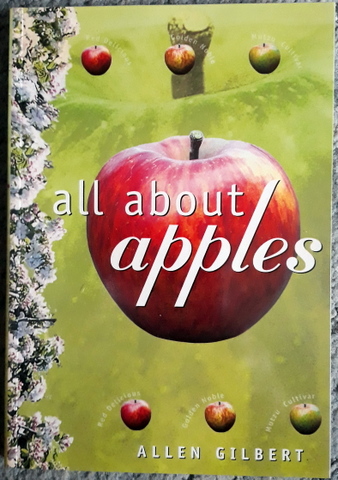
Citrus: A Gardener’s Guide – Bruce Morphett & Ian Tolley – Government of South Australia (AUS) 2011 (reprint) ISBN 978 0 7308 6225 9 – This is a small book, A5 size and 76 pages. There is an introduction that summarises the key steps for success in growing citrus, then the first chapter talks about citrus varieties and the rootstocks available. Chapter two covers growing citrus including establishing young trees, maturity and harvesting and growing it pots. The third chapter, taking up the remainder of the book, covers citrus pests and diseases, control is organic in nature. For a small book, it covers its chosen subjects well; it has lots of colour photos and some line drawings.
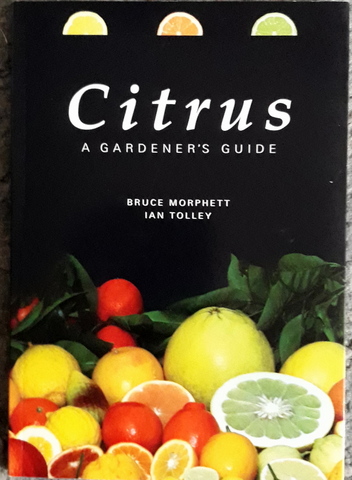
The Olive Book – Gareth Renowden – Canterbury University Press (NZ) 1999 ISBN 978 0 908812 80 9 – The book is a good overview but no great depth in the chapters. Chapter one is an introduction to olives and the reality of managing an olive grove, chapter two talks about olive botany, history and olive oil chemistry. Chapter three talks about where olives are grown throughout the world and chapter four discusses olives from tree to table. Chapter five discusses olive oil uses, chapter six covers getting a olive grove started including climate, water, wind, aspect, access and bureaucracy. Chapter seven goes into the financial side of starting your olive grove and chapter eight discusses the aspects associated with choosing the right cultivars. Chapter nine covers planting the grove and chapter ten covers managing it, including pruning, irrigation and coping with frost. Chapter eleven lists pests, diseases and other problems but does not offer much in the way of solutions. Chapter twelve talks about options for oil production, chapter thirteen talks about how to treat olives for eating. Chapter fourteen talks about olive cuisine and how they are prepared and used. The book has lots of colour photos.
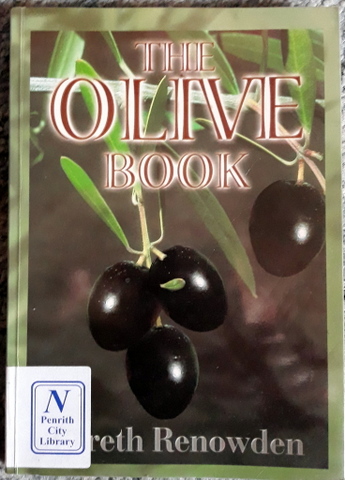
Fruit Trees in Small Spaces – Colby Eierman – Timber Press (US) 2012 ISBN 978 1 60469 190 0 – This book focusses on stone fruits, pome fruits and citrus. The book is broken up into four parts. Part one is planning the orchard and starts out detailing all the takes which need to be done throughout the year and then looks at the issues associated with orchard design including understanding your site, design elements and design ideas. Part two is a guide to choosing the right fruit trees and covers rootstocks as well as monographs detailing each type of fruit tree, including varieties (in the US), how to grow, pruning, pests and diseases including organic controls and cultural problems. Part three covers setting up and maintaining a small scale orchard including planting, irrigation, pruning and training. Part four provides sixteen fruit based recipes for your harvest. The book has lots of colour photos.
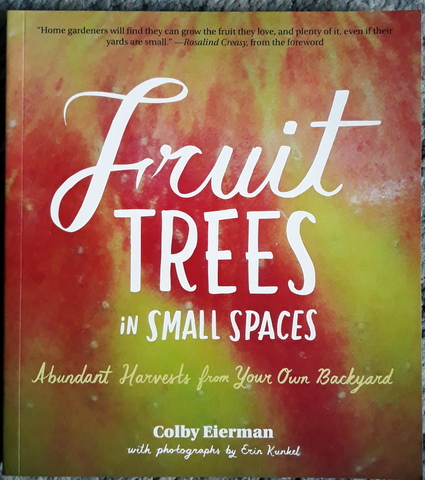
What’s Wrong with my Fruit Garden – David Deardorff & Kathryn Wadsworth – Timber Press (US) 2013 ISBN 978 1 60469 358 4 – This incredibly detailed and handy book is written in three parts, the first part is an introduction and covers problems fruit trees have that are associated with environmental problems including temperature, soil, light and water that includes a series of photos of examples of problems caused by each one. Part two ‘plant portraits’ is a series of monographs covering 37 fruits and nuts starting with a plant description then covering temperature, soil, light, water, garden uses, pollination, pruning and problem solving. Part three is the meat of the book and is a problem solving guide for 21 fruit, with the entry being for a single fruit like figs or a fruit family like pome, stone or citrus fruit. Each guide provides a series of entries, each one starting with a colour photo of the issue, followed by a description of symptoms, diagnosis of the cause and a series of solutions. The solutions are referenced to a page in the part of the book called ‘Organic solutions to common problems’ which gives detail on each solution and how it is carried out. The book has lots of colour photos.
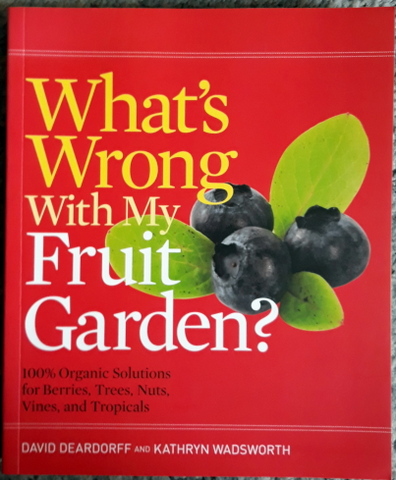
Community Orchards Handbook – Angela King and Sue Clifford (Common Ground) – Green Books (UK) 2011 ISBN 978 1 900322 92 8 – This is a great little book with lots of information but in terms of legalities and processes it reflects the UK experience. Chapter one is a short introduction to local orchards in the UK, Chapter two covers what a community orchard is, chapter three talks about the place of orchards in landscape and (UK) culture, chapter four details previous community orchard success stories. Chapter five details getting a community orchards started, from getting support, access, insurance and even writing a constitution. Chapter six talks about getting more information through wildlife mapping, an apple survey or parish fruit map. Chapter seven covers the issues associated with planning the orchard, and chapter 8 talks about adopting an older existing orchard. Chapter nine covers attracting and conserving wildlife in the orchard area, and chapter ten discusses options for sharing and processing the harvest. Chapter eleven talks about ways to celebrate the orchard such as wassailing and apple day (UK) and chapter twelve covers how to safeguard the orchard and preventing local and historic orchards being ‘developed’. The book has lots of colour photos.
